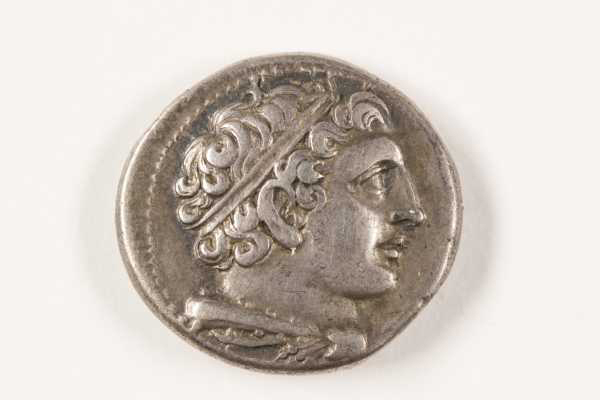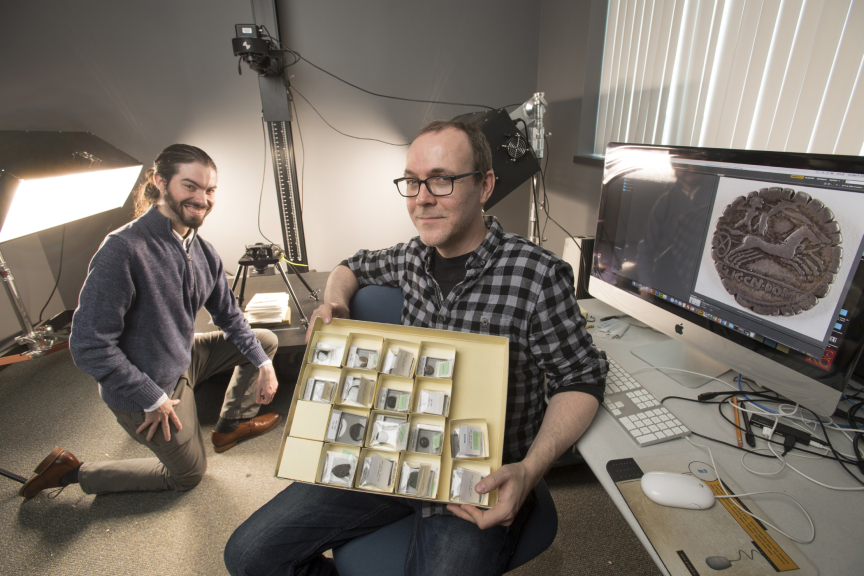Rutgers Digitizes Roman Coin Collection, Making It Accessible to the World
Knowledge, technology, patience open new knowledge of ancient Roman life

The Rutgers University Libraries has digitized an invaluable collection of 1,250 coins from the ancient Roman Republic.
Through a collaboration of classical scholarship and super high-resolution photography, the goal was to make multi-angle views of these coins – some of copper, some of bronze, silver or gold, all bearing fascinating engravings – available for study by scholars and students while protecting the originals.
Anyone with an internet connection can now zoom and pan all 1,250 digitized coins free of charge, via the Coins portal. Visitors to the Alexander Library at Rutgers University–New Brunswick can view several of the actual coins, along with reproductions of the new digital images, at an exhibit opening March 23 in the Scholarly Communication Center.

“These coins, housed at the Libraries’ Special Collections and University Archives, are an invaluable resource for anyone studying Roman political and cultural history,” said T. Corey Brennan, a professor of classics at the School of Arts and Sciences who uses the coins in his courses. “You can see the monetary system being constructed, with lots of experiments and dead ends along the way. We’re now making them available to anyone with a computer and an internet connection. It’s a true gift of knowledge to the world.”
The Badian Collection of Coins of the Roman Republic is named for Ernst Badian, the late Harvard University professor who donated the vast collection to Rutgers thanks to his connection to Brennan, who was his student.
“The Libraries, the Classics Department and the School of Communication and Information all collaborated to make this happen,” said Ronald Jantz of the Shared User Services unit of the Rutgers University Libraries, who oversaw the digitization project along with Brennan.
The bulk of the work was done by Rick Hale, a classics doctoral student in the School of Graduate Studies, four library school students from SC&I and several part-time library employees. The digitization, description of the coins, and upload to Rutgers Institutional Repository (RUcore) spanned about four years and required patience, skill, knowledge of ancient coins, advanced technology and improvisation.

Each coin had to be photographed several times to give online users the ability to view it from several angles, including slanted visuals to show the depth of the impressions. Jantz, Hale and their teammates wrote descriptions for each coin that allow users to search by type of metal, denomination, the person depicted on the coin and more.
“At first, showing multiple angles for each coin meant we had to manipulate them manually — shoot straight on, move the coin a few degrees, shoot that image, and so on,” Hale said.
Although the multiple-angle approach did have some advantages, the Coins team switched to taking images of the obverse and reverse of each coin in order to expedite the imaging process. Late in the project, Aaron Hershkowitz, also a classics doctoral student, joined the team and brought with him a knowledge of a new technology, “reflectance transformation imaging,” or RTI, with which Hale and Hershkowitz began to experiment toward the end of the project. In RTI, the coin is placed inside an LED-studded dome, making it possible to shoot multiple views by manipulating the lights, not the coin. The RTI technology holds great promise for continuing to improve the coin imaging process.
Each coin in the Badian collection tells a story, some quite intriguing. After Julius Caesar’s assassination, a coin was minted showing the heads of Mark Antony and Octavian – who later became Augustus Caesar – on the same coin, thus capturing a brief moment when the two were allies. Antony and the Egyptian Queen Cleopatra subsequently lost an infamous civil war fought against Octavian and committed suicide.